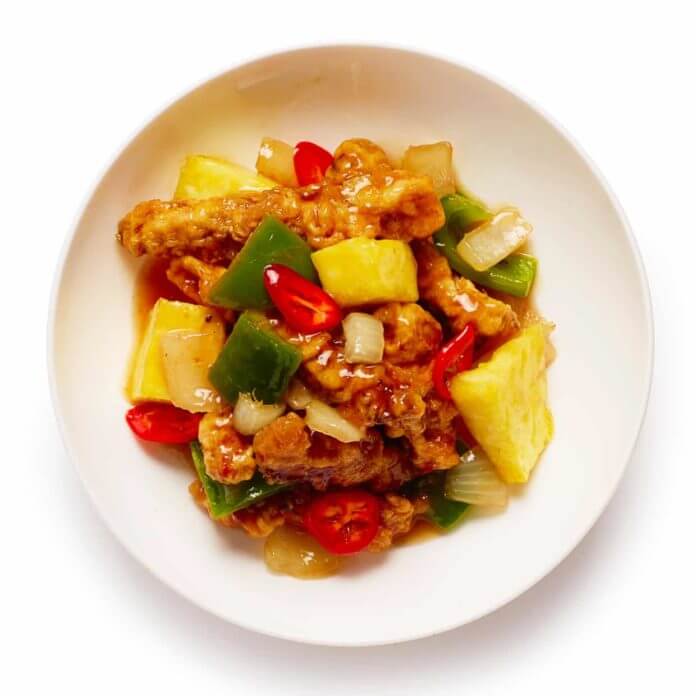Had enough of the sticky, sugary sauce found in high-street takeaways? Here’s a sharp, fruity version of the Chinese favourite.
weet and sour pork is a dish with a reputation problem; one of the first Chinese foods many Britons will try, sugary and deep-fried, it’s a guaranteed crowd pleaser often wrongly dismissed as westernised junk. Prepared with care, however, and tailored to your own palate, sweet and sour pork – or, indeed, chicken, fish or tofu – can be as delicious as the first time you tasted it.
Though this flavour combination is common throughout China, often in the form of a dipping sauce, like many British favourites, the version we know best comes from Guangzhou, and is a staple of the bright and noisy Hong Kong diner – though its fame has spread worldwide for the very simple reason that it hits all the right notes, wherever you are. Savoury and crunchy, sweet and tangy: it’s addictive stuff. Treat with caution.
Though it can be tailored to just about any protein you like, I think the juicy texture of pork works particularly well in this dish and, according to YouTubers Steph and Chris of Chinese Cooking Demystified, “older variants… use pork belly instead of loin. At most restaurants nowadays, you’ll see this with lean meat, though, and we do prefer it here.” I’m inclined to agree: the edge of the fat on the pork belly used by Yan-Kit So in her Classic Chinese Cookbook goes deliciously crisp in the fryer, but the rest becomes annoyingly chewy; belly is a cut better slow cooked.
To my surprise, however, the spare ribs used in Kei Lum and Diora Fong Chan’s China: The Cookbook work much better, the meat remaining soft and juicy, while the bony bits are little more than vehicles for batter. Some of my testers find them a bit fiddly, however, so I’m going to stick with loin, though I would urge anyone who doesn’t mind getting up close and personal with some bones to give them a try (get your butcher to chop them up first; they’re pretty hard on the old cleaver).
Cut the meat nice and small; Anglo-Chinese food writer Lizzie Mabbott muses: “I would go with pork shoulder strips. Chunks seem only appropriate for chicken, but I can’t explain why.” Having chewed my way through the great Ken Hom’s mighty 5cm cubes of fatty pork neck, I can explain why: chicken is a softer meat, pork has more heft to it.
Loin might not need much in the way of tenderising, but a brief marinade will always add flavour; we particularly like the garlicky soy mixture used by Amy and Julie Zhang in their Dumpling Sisters Cookbook. I don’t think you need to add any sugar at this point, because the sauce will be sweet anyway, but testers do enjoy the warmth of Chinese five spice in the recipe in Charmaine Solomon’s Complete Asian Cookbook.
Slimmers stop reading now: though you can find recipes, like that from Ching He Huang, which simply stir-fry the meat, this is not health food – most sweet and sour pork is deep-fried, often doubly so, to make it “very crisp”, as Solomon puts it. You could skip the initial fry and blanch the pork first instead, as the Zhangs suggest, but that’s a bit of a faff, and I think has a tendency to make the meat slightly tough. Plus it means another pan to wash up.
Given that the pork will be tossed in the sauce before serving, it’s important to make the batter robust enough to survive a dunking; Solomon’s whisked egg-white coating, while almost tempura-like in its lightness, collapses into a soggy mess when it hits the wok. Far more successful is Steph and Chris’s triple coat of starch, which starts by dusting the meat with cornflour to help the batter stick, before dunking it into a “nice, thick” flour-and-egg mixture, and finishing off with a final layer of cornflour to “get that classic sort of gulurou [sweet and sour ] shape and texture”. It’s sturdy enough to maintain some crunch on the plate, and thick enough to keep the meat within tender – and, most importantly, completely delicious.
The sauce
The protein is a movable feast, however; you could probably even make this dish from battered Mars bars if you wanted, because the important thing is the sauce. Chef Jeremy Pang of School of Wok writes in his book Chinese Unchopped: “In the old days (way before the internet), sweet and sour was not red in colour at all, as it was predominantly made up of vinegar, sugar and dark soy sauce. However, with the heavy influence western culture now has, the Cantonese have found that ketchup provides the perfect balance and wrapping consistency for this dish. Who’s to say this recipe upgrade isn’t just as authentic as the old ways? As with any culture as it changes and adapts, it doesn’t make its expressions any less authentic; it just makes them a product of the times.”
Lum and Chan stick with this old version, making a sauce from red vinegar and brown sugar that proves surprisingly effective, and, as Steph and Chris note, there’s nothing wrong with using ketchup, it’s “been around in China since around the turn of the 20th century”. But having done some investigation as to what came before, they conclude the “predominant opinion is that the sauce was made using shanzha, known in English as Chinese hawberry. Shanzha is an incredibly tart fruit that looks a bit like a small apple and has this vibrant red skin.” It’s not easy to find out of season, even in China: chef Lap-fai Lee, who put me on to the hawberry idea in the first place, recommends a Chinese sweet called haw flakes, which I fail to find in any of my three local oriental supermarkets,. Happily, they recommend a slightly surprising alternative: apricot jam mixed with cranberry puree, which, they say, with a squeeze of lemon juice, makes “something that, while certainly not 100% the same as shanzha sauce, is pretty close”.
They concede, however, that “if you don’t feel like screwing around with these fruit pastes, obviously don’t hesitate to reach for the ketchup. Basically every restaurant in Guangdong uses it, the vast majority of families use it … it’s absolutely an authentic addition to the dish.” I try a dollop of trusty Heinz in the Zhangs, So and Solomon’s recipes, and find that, when mixed with extra vinegar and sugar, it does indeed produce a sauce very close to the stuff I remember from restaurants – though not, it must be noted, quite as sweet and orange and gloopy as the glorious “proper sweet and sour sauce, like you get from a takeaway” made by chefs Chin and Choo Ziang using distilled malt vinegar and orange squash – “if you’ve ever wondered what that flavour is you can’t quite grasp, it’s orange squash”.
Ken Hom, meanwhile, uses fresh orange juice, and So puts in pineapple juice – the extra citrussy tang of all of the versions using fruit prove more popular than the tasty but somewhat one-dimensional ketchup-only recipes, but most popular of all is the jam mixture, which has a fruity depth to it that the others lack, with a distinct berry sharpness from the cranberries. As I don’t have a particularly sweet tooth, I’m going to cut back on the sugar slightly (soft light brown makes a decent substitute for palm sugar here) – though feel free to adjust to your taste – and add a dash of soy sauce and Hom’s red rather than white vinegar, to help balance the potentially cloying sweet and sour flavours.
Once you’re happy with the flavour, you’ll need to thicken it: both cornflour and potato starch work fine for this purpose.
The vegetables
Many sweet and sour recipes are very simple indeed: Hom’s contains just shallots in the way of vegetable matter, and the Zhangs stick with the classic pineapple flavoured with ginger and garlic, but I think it’s far more interesting with a few other contrasting flavours and textures. I try spring onions, peas and water chestnuts, but come back to the traditional onion and green pepper pairing favoured by So, with extra pineapple – because, let’s be honest, it’s delicious – plus a sprinkling of Steph and Chris’s mild red chilli for warmth and colour. Use whatever you like, but just make sure you cut it fairly small so it stir-fries evenly.
Perfect sweet and sour pork
Prep 20 min + marinating time
Cook 10 min
Serves 2
200g pork loin or lean shoulder
1 garlic clove, peeled and crushed
1 tbsp light soy sauce
1 tbsp rice wine or dry sherry
½ tsp salt
¼ tsp Chinese five-spice powder (optional)
To cook
1 onion
1 green pepper
1 mild red chilli
1 egg
60g cornflour, plus extra to coat
Vegetable oil, to fry
100g pineapple chunks
For the sauce
2 tbsp apricot jam – the lower in sugar, the better
1 tbsp cranberry sauce, ditto
1 good squeeze lemon or lime juice
25-40g soft light brown sugar
2.5 tbsp Chinese red vinegar (ideally), or rice vinegar
1 tbsp light soy sauce
1 tsp cornflour
Serve with egg fried rice and probably something fresh and green
Cut the pork into strips about 1cm wide. Put in a bowl, toss with the garlic, soy, rice wine salt and five spice, and leave to marinate for at least 30 minutes.
Meanwhile, prepare the sauce by stirring together the preserves and adding the citrus and sugar. Stir until the sugar dissolves, then stir in the vinegar, soy and 90ml water. Season to taste, adding more sugar, if you like. In a separate small bowl, stir together the cornflour and a teaspoon of cold water.
Cut the onion and pepper into chunky diamonds, separating the onion layers as you go. Slice the chilli into rings.
Beat the egg in a bowl until smooth, then stir in 60g cornflour to make a smooth batter, and season. Tip an extra tablespoon of cornflour into the pork and toss to coat. Coat a plate with more cornflour. Pour vegetable oil into a large pan or wok to fill by a third and heat to 180C /350F.
Once the oil is nearly at temperature, dunk the pork in the batter, then shake off any excess and roll it in the plate of cornflour to coat. Fry in the hot oil for three minutes, until golden, then remove with a slotted spoon and drain on kitchen paper. Keep the oil warm.
Heat a tablespoon of vegetable oil in a wok until smoking, then stir-fry the onion, pepper and chilli until softened. Tip in the sauce mixture, bring up to a boil, then stir in the cornflour and water mixture, and cook until thickened. Add the pineapple and keep warm on a low heat.
Heat the oil back up to 190C/375F and fry the pork for 30 seconds, until golden, then scoop out with a slotted spoon and transfer to the sauce. Turn up the heat, toss everything together, tip out on to a plate and serve immediately.
Refry the pork, add to the sauce, and serve.
• Sweet and sour: do you like the sharp, fruity hawberry version, or proudly prefer the sticky, sugary dish perfected by the high-street takeaway, whether with chicken, prawns or even tofu? And which other restaurant favourites would you like to recreate at home?




